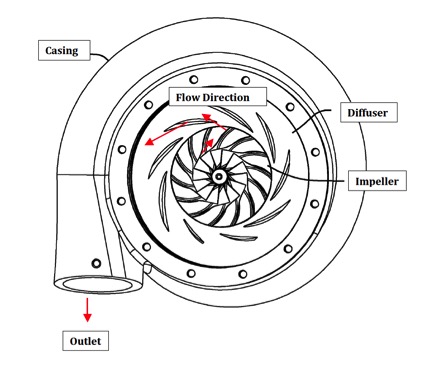By Tim Dugan, P.E. President, Compression Engineering Corporation
Larger air compressors, typically over 500 hp, in refineries, pulp and paper plants, chemical and other processing plants often have high-speed, multi-stage air compressors called “centrifugal” air compressors. As seen from a total system perspective, they are not much different than screw air compressors. They compress air to plant pressure from atmospheric conditions, and deliver it to the dryer. These types of air compressors have no internal wearing parts, besides bearings and seals, and are very reliable and efficient, at their best efficiency point.
Centrifugal air compressor flow rate is relatively constant at a given pressure and inlet temperature, at full load. In common screw air compressor parlance, they are considered “base-load”, meaning they should be running at full capacity all the time. That is a simplified, but correct view of how one should see most applications of centrifugal air compressors, if in fact there are properly controlled screw air compressors used as “trim”, and their inlet conditions are relatively constant. However, in most actual systems with centrifugal air compressors, they are not running base-loaded, and inlet conditions change dramatically throughout the seasons. Sometimes, centrifugal air compressors are in a centrifugal-only system, where they are oversized and at a poor part-load efficiency point, with one running and one in back-up. Or there are multiple units running at different parts of a large plant air system, running independently, sometimes efficiently and sometimes not. Or they are in mixed screw / centrifugal systems where they are running in parallel with the screw air compressors, also at part load. In our view, a common reason for these less than optimal applications is the lack of knowledge of controls and maintenance by most vendors, technicians and engineers who are more familiar with screw air compressors.
In this article, I aim to describe the essential way a centrifugal air compressor is controlled and how to size one properly. In order to do so, I need to cover some basics, as follows:
- Describe centrifugal air compressor basics.
- Describe a centrifugal air compressor’s curve.
- Describe centrifugal air compressor control.
- Discuss implications for air compressor sizing.
Centrifugal Air Compressor Basics
A centrifugal air compressor develops pressure by accelerating a gas from the center of the impeller, through the “impeller”, by centrifugal force, and then slowing it down in a “diffuser” through expansion. The velocity energy is converted into pressure energy (by Bernoulli’s principle, pressure is inversely proportional to velocity squared). See Figure 1.

